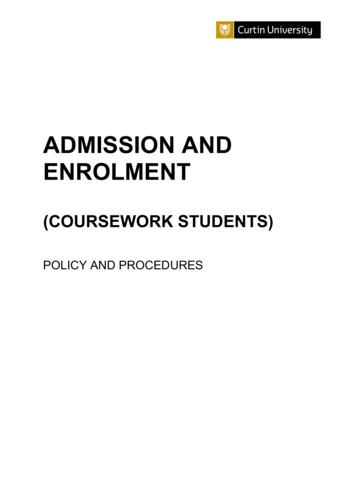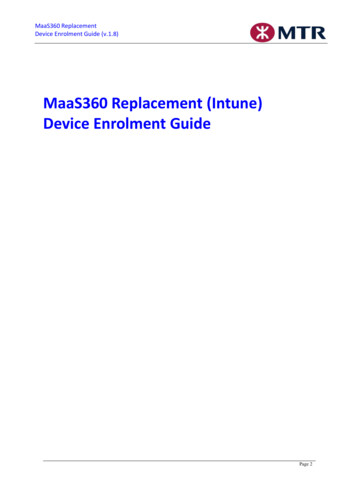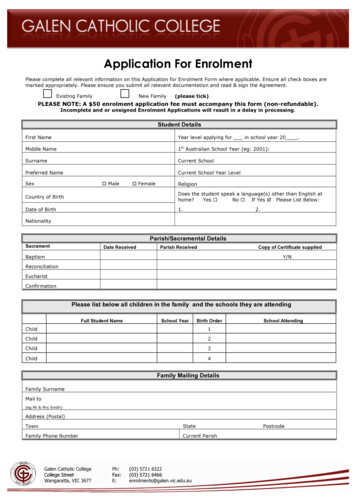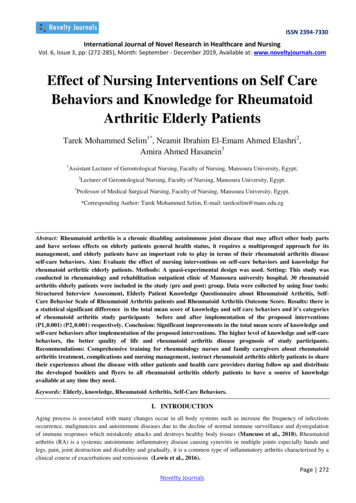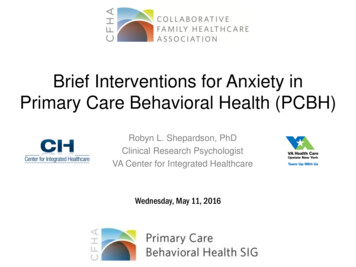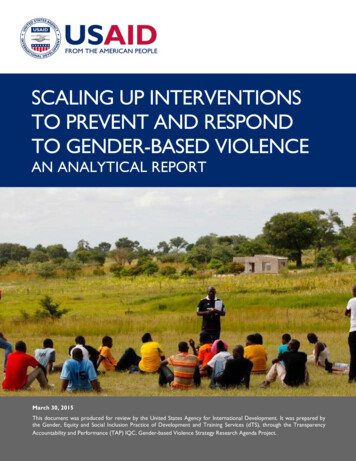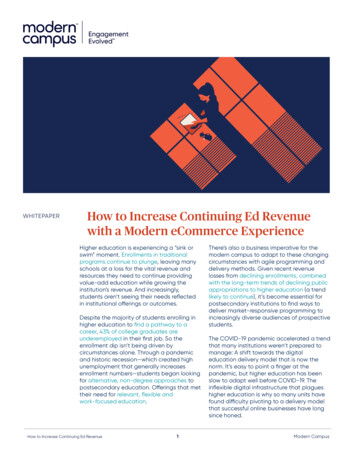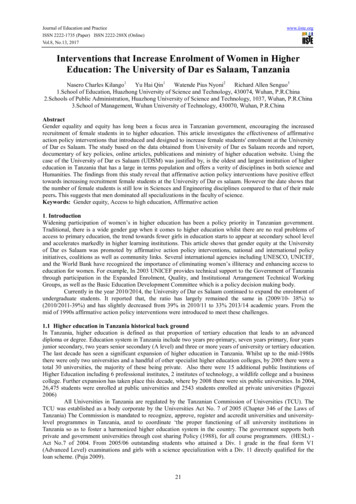
Transcription
Journal of Education and PracticeISSN 2222-1735 (Paper) ISSN 2222-288X (Online)Vol.8, No.13, 2017www.iiste.orgInterventions that Increase Enrolment of Women in HigherEducation: The University of Dar es Salaam, TanzaniaNasero Charles Kilango1Yu Hai Qin1Watende Pius Nyoni2Richard Allen Senguo31.School of Education, Huazhong University of Science and Technology, 430074, Wuhan, P.R.China2.Schools of Public Administration, Huazhong University of Science and Technology, 1037, Wuhan, P.R.China3.School of Management, Wuhan University of Technology, 430070, Wuhan, P.R.ChinaAbstractGender equality and equity has long been a focus area in Tanzanian government, encouraging the increasedrecruitment of female students in to higher education. This article investigates the effectiveness of affirmativeaction policy interventions that introduced and designed to increase female students' enrolment at the Universityof Dar es Salaam. The study based on the data obtained from University of Dar es Salaam records and report,documentary of key policies, online articles, publications and ministry of higher education website. Using thecase of the University of Dar es Salaam (UDSM) was justified by, is the oldest and largest institution of highereducation in Tanzania that has a large in terms population and offers a verity of disciplines in both science andHumanities. The findings from this study reveal that affirmative action policy interventions have positive effecttowards increasing recruitment female students at the University of Dar es salaam. However the date shows thatthe number of female students is still low in Sciences and Engineering disciplines compared to that of their malepeers. This suggests that men dominated all specializations in the faculty of science.Keywords: Gender equity, Access to high education, Affirmative action1. IntroductionWidening participation of women’s in higher education has been a policy priority in Tanzanian government.Traditional, there is a wide gender gap when it comes to higher education whilst there are no real problems ofaccess to primary education, the trend towards fewer girls in education starts to appear at secondary school leveland accelerates markedly in higher learning institutions. This article shows that gender equity at the Universityof Dar es Salaam was promoted by affirmative action policy interventions, national and international policyinitiatives, coalitions as well as community links. Several international agencies including UNESCO, UNICEF,and the World Bank have recognized the importance of eliminating women’s illiteracy and enhancing access toeducation for women. For example, In 2003 UNICEF provides technical support to the Government of Tanzaniathrough participation in the Expanded Enrolment, Quality, and Institutional Arrangement Technical WorkingGroups, as well as the Basic Education Development Committee which is a policy decision making body.Currently in the year 2010/2014, the University of Dar es Salaam continued to expand the enrolment ofundergraduate students. It reported that, the ratio has largely remained the same in (2009/10- 38%) to(2010/2011-39%) and has slightly decreased from 39% in 2010/11 to 33% 2013/14 academic years. From themid of 1990s affirmative action policy interventions were introduced to meet these challenges.1.1 Higher education in Tanzania historical back groundIn Tanzania, higher education is defined as that proportion of tertiary education that leads to an advanceddiploma or degree. Education system in Tanzania include two years pre-primary, seven years primary, four yearsjunior secondary, two years senior secondary (A level) and three or more years of university or tertiary education.The last decade has seen a significant expansion of higher education in Tanzania. Whilst up to the mid-1980sthere were only two universities and a handful of other specialist higher education colleges, by 2005 there were atotal 30 universities, the majority of these being private. Also there were 15 additional public Institutions ofHigher Education including 6 professional institutes, 2 institutes of technology, a wildlife college and a businesscollege. Further expansion has taken place this decade, where by 2008 there were six public universities. In 2004,26,475 students were enrolled at public universities and 2543 students enrolled at private universities (Pigozzi2006)All Universities in Tanzania are regulated by the Tanzanian Commission of Universities (TCU). TheTCU was established as a body corporate by the Universities Act No. 7 of 2005 (Chapter 346 of the Laws ofTanzania) The Commission is mandated to recognize, approve, register and accredit universities and universitylevel programmes in Tanzania, anzd to coordinate ‘the proper functioning of all university institutions inTanzania so as to foster a harmonized higher education system in the country. The government supports bothprivate and government universities through cost sharing Policy (1988), for all course programmers. (HESL) Act No.7 of 2004. From 2005/06 outstanding students who attained a Div. 1 grade in the final form V1(Advanced Level) examinations and girls with a science specialization with a Div. 11 directly qualified for theloan scheme. (Puja 2009).21
Journal of Education and PracticeISSN 2222-1735 (Paper) ISSN 2222-288X (Online)Vol.8, No.13, 2017www.iiste.orgThe UDSM as selected as a study sample began its history in 1961 as a College of the University ofLondon, with only one faculty (Law) and fourteen students. Together with Makerere University College inUganda and Nairobi University College in Kenya, it became a Constituent College of the University of EastAfrica in 1963.The national university, UDSM, was established in August 1970. The primary focus of theUDSM was to be an institution where people are trained at the highest level for clear and independent thinking,analysis and problem solving. In 2005, UDSM had a total of 12 945 students, making it the biggest university inthe country. It has the largest intake of students and offers the widest selection of courses, amounting to 53degree programmers. (www.tanzania.go/msthe).1.2 Gender equity and high education in Tanzania.Gender equity in higher education is more than putting women on equal footing with men it is eliminatingbarriers to participation and stereo types that limit the opportunities and choices of both sexes. Gender equity isabout enriching classrooms, widening opportunities, and expanding choices for all students (Bailey 1996). Sincethe independence 1961 the government of Tanzania has put in place a sector wide approach to education and theEducation Sector Development Programme in an effort to reduce gender disparity in the education sector and toimprove the quality of education. The international and regional agreements related to women’s rights havedeveloped a number of national policies that constitution bans discrimination on whatever grounds. On anotherhand the National Education and Training Policy of 2002, National Education Act of 1978 and the NationalHigher Education Policy of 1999 provides guidelines for achieving gender equity and equality in the variouslevels of education (Onsongo 2009).Gender inequality in Tanzanian higher learning institution started during the transition from primary tosecondary schools. However the government has achieved gender parity in primary and secondary schoolenrolments hence girls’ performance in the primary school leaving examination results remains lower than boys’,and gender differentials in enrolment widen in higher secondary and in higher levels of education. For example,by 2011, out of 325,799 (136,629-girls, 187,170-boys) ‘Form IV’ students who were examined for the finalCertificate of Secondary Education Examination, those who qualified for Form V and Technical Educationselection were 31,658 (9.72%) of present candidates. Total selected candidates were 31,423 (9.64%), of whichgirls were 9,369 (6.76% of all present girls) and boys were 22,054 (11.78% of all present boys). this suggest that,very few girls will complete Form VI and Technical Education, and consequently be eligible to enroll foruniversity studies.(Lihamba, Mwaipopo et al. 2006).2. Data and Methodology.Available data used in this paper to find out the facts behind the effectiveness of interventions introduced anddesigned to increase female students' enrolment at UDSM. The data were gathered from the University of Dar esSalaam records and report, books as well as documentary of key policies, online articles, publications and theministry of higher education website. The data was analyzed using qualitative and quantitative methods. Theselection of the study sample (UDSM) was justified by, was the oldest and largest institution of higher educationin Tanzania that has a large in terms population. The data presented in statements and in some few cases tablesand figures to enable a quick grasping of the specifics.3. Theoretical perspective3.1 Gender equity and accessAccording to the Liberal feminism theory, feminist’s belief in equality for women and men, this school ofthought rooted in the belief that women as well as men are rights bearing and autonomous human beings. Theliberal feminists' theory includes the claim that the abolition of gender segregation of occupational roles isnecessary for the achievement of women's equality. Liberal feminists believe changes in equal opportunities andeducational policies, e.g. the National Curriculum, will end patriarchy, (Agassi 1989). Over the decade, issuesconcerning women have taken new dimension and received varied treatment by the United Nations and itsspecialized agencies. The principle of equality of men and women was first recognized in (1945) in the UnitedNations charter and subsequently in the universal deceleration of human rights (1948) (Morley 2005). Since then,the UN has helped create a historic legacy of internationally-agreed strategies, standards, programmes and goalsto advance the status of women worldwide. Over the years, the UN and its technical agencies have promoted theparticipation of women as equal partners with men in achieving sustainable development, Education, and fullrespect for human rights. The empowerment of women continues to be a central feature of the UN's efforts toaddress social, economic and political challenges across the globe.The United Nations Decade for Women (1975–1985) had an impact on issues of gender in Tanzania.The United Nations Development Fund for Women (UNIFEM) was created as a separate and identifiable entitywithin the UN system in autonomous association with the United Nations Development Programmer. Oneamong of the objective of UNIFEM was to promote women’s participation in the decision-making of mainstream22
Journal of Education and PracticeISSN 2222-1735 (Paper) ISSN 2222-288X (Online)Vol.8, No.13, 2017www.iiste.orgdevelopment programmes and equality of women in the developing world.The World Education Forum’s participants in Ensuring that, by 2015 all children particularly girlschildren in difficult circumstances and those belonging to ethnic minorities have access to and complete free andcompulsory primary education of good quality and eliminating gender disparities in primary and secondaryeducation by 2005, and achieving gender equality in education by 2015, with a focus on ensuring girls’ full andequal access to and achievement in basic education of good quality(Lihamba, Mwaipopo et al. 2006). TheUNESCO World Conference on Higher Education (1998) demanded the elimination of all gender stereotyping inhigher education envisaging elimination at all levels and in all disciplines in which women are under-representedand an increase of women’s active involvement in decision-making.3.2 Affirmative action historical back ground.Affirmative action refers to a body of policies and procedures designed to eliminate discrimination againstmarginalized groups including ethnic minorities, and women. Its main objective is to redress the effects of pastdiscrimination (Onsongo 2009). (Pojman 1998), admitted that, AA includes any policies that attempt to activelydismantle institutionalized or informal cultural norms and systems of inscriptive group based disadvantages, andthe inequalities historically resulting from them, and also to promote an ideal of inclusive community, as inideals of democracy, integration, and pluralism, by means that classify people according to their inscriptiveidentities, for example race, gender, ethnicity and sexual orientation. (Tierney 1997), identified three forms ofAA as compensatory procedure to address past injustices, a corrective tool to address present discrimination andan intervention to promote social equality and diversity in a given societyIn the USA, AAs have been used to give preference of access to disadvantaged minority groups(including African–Americans, Latin-Americans, and Native-Americans) and to women. AAs have also beenused to promote group cultural identities and inculcate the understanding that it is a right to make such demands.Initially AA policies focused on improving opportunities for African Americans in employment and education,outlawing school segregation and improving life prospects for African Americans. According to data from theNational Center on Education Statistics (NCES), in 2007, 70 percent of white high school graduates immediatelyenrolled in college, compared to 56 percent of African American graduates and 61 percent of Hispanicgraduates. More recent data from NCES reports some changes in this gap, most notably for African Americanstudents. The updated report finds that in 2011, 69 percent of white high school graduates immediately enrolledin college, compared to 65 percent of African American graduates and 63 percent of Hispanic graduates.(National Center on Education Statistics (NCES). Affirmative action in Tanzania is a constitutional issue thatfemale representation in the professions and politics was very low. The Constitution 1977 stipulates theproportion of women in all sectaries, particularly in parliament through women special seats to be not less than30 percent of all members (Constitution of the United Republic of Tanzania 1977). In 1990 the ruling Partyintroduced guidelines for increasing women's representation in Parliament where by only 11% were members ofthe parliament. In 2001 the number increased to 22.5% and in the current 2005–2010, female representation inthe parliament has reached the projected 30%.3.3 Affirmative action in Tanzania higher institutions.Affirmative action (AA) has been practiced in Tanzania since the early 1990s. In institutions of higher education,affirmative action refers to admission policies that provide equal access to education for those groups that havebeen historically excluded or underrepresented, such as women and minorities. (Wanyande 2003). TheTanzanian government has put in place a sector wide approach to education and the Education SectorDevelopment Programme in an effort to reduce gender disparity in all levels of education. The MusomaResolution of 1974 was the first of affirmative action policy interventions that resulted in the increase of femaleenrolment at UDSM. Through the Musoma Resolution, females were able to enter the University directly fromsecondary schools and were thus exempted from 2 year compulsory work period that their male counterpart(Lihamba, Mwaipopo et al. 2006).In1977, The Government has developed various plans based on macro and, sector policies committed toachieve Universal Primary Education (UPE). The government managed to create a near equity gender enrolmentin primary schools where by through UPE programs enrolment had risen to 93% in 1980. The objectives of theUPE plans were to enhance access and equity, improve quality, strengthen capacities, address cross cuttingissues, strengthen institutional arrangements, undertake educational research, and conduct educationalmonitoring and evaluation. On other hand the Government of Tanzania launched the Primary EducationDevelopment Plan (PEDP) in 2002. The aims were to materialize Tanzania’s commitment towards the globalEducation for All (EFA) targets articulated by the international community in Jomtien and Dakar. The mainpriority of PEDP is to increase equal enrolment of girls and boys.The country has signing international and regional agreements related to women’s rights, which developa number of national policies. The Women Development and Gender Policy 2000 provide policy guidelines to23
Journal of Education and PracticeISSN 2222-1735 (Paper) ISSN 2222-288X (Online)Vol.8, No.13, 2017www.iiste.orgother sectors on how to achieve gender equality and equity. The National Education and Training Policy of 2002,National Education Act of 1978 and the National Higher Education Policy of 1999 provide guidelines forachieving gender equity and equality in all levels of education (Onsongo 2009). The higher EducationDevelopment Programme (2010 – 2015) envisages addressing issues of access and equity of women in highereducation in relation to increased enrolment of female students especially in science and technologyprogrammes, to provide friendly physical learning environments, loans, grants and scholarships. The Tanzaniangovernment is also a signatory to the UNESCO Convention against discrimination in education. Government hasratified the African charter on Human and People’s Rights (1981) and the Southern Africa DevelopmentCooperation (SADC), Declaration on Gender and Human Rights (1997).4. Affirmative action programmers at UDSMGender inequality in fields of studies is common and typically based of Science subjects and Arts subjects, veryfew female students are admitted in science fields especially in Mining Engineering, Mechanical Engineering,and Civil Engineering etc (Petro, Wasson et al. 2011). At (UDSM), the AA policy was instituted in 1997/1998academic year. Several strategies have been introduced to facilitate the entry of more female students at theUniversity of Dar es Salaam. For example, higher enrolments for female students has be achieved by loweringthe entry cut-off point by 1.5 points for women, female students assisted by being given remedial classes in orderto improve their performance and retention in science and mathematics subjects and giving undergraduateScholarship which for three years benefited 50 female students each year under its programme, and an initiativefor enrolment of female students in the Engineering disciplines.(Morley, Leach et al. 2010).The discussions focus on three affirmative action programs and the procedures used in implementingthe various interventions that have been implemented at UDSM to increase women’s enrollments. These includelower entry scores, remedial pre-university programmers and financial assistance. In general variousinterventions have increased the number of women enrolled at the University of Dar es Salaam however the ratioof female students has largely remained below 30% over the couple of years. In the Faculty of Science, femaleenrolment had been 16% in 1996 but rose to 27% in 2003/2004. In Engineering it rose from 7% in 1996 to 13%in 2003/04 while the Faculties of Arts and Social Sciences, and Law had reached parity by 2004 (Morley, Leachet al. 2010).The data in Table 1 shows the Percentage of female students admitted before and after affirmativeaction in 2000/2001 in UDSM. The date shows that, there was an increase in the number of female studentsadmitted to the University of Dar es Salaam in a number of courses after the use of affirmative action. Thepercentage of female students admitted without affirmative action in the year 2000–2001 was 15% while withaffirmative action it increased to 27% (FAWE 2001). After affirmative action female enrolments in law,education and medicine were under 50% except arts with 51%.Table1. Percentage admitted before and after affirmative action in 2000/2001 in U
Education: The University of Dar es Salaam, Tanzania . education in Tanzania that has a large in terms population and offers a verity of disciplines in both science and . Higher Education including 6 professional institutes, 2 institutes of technology, a wildlife college and a business college
